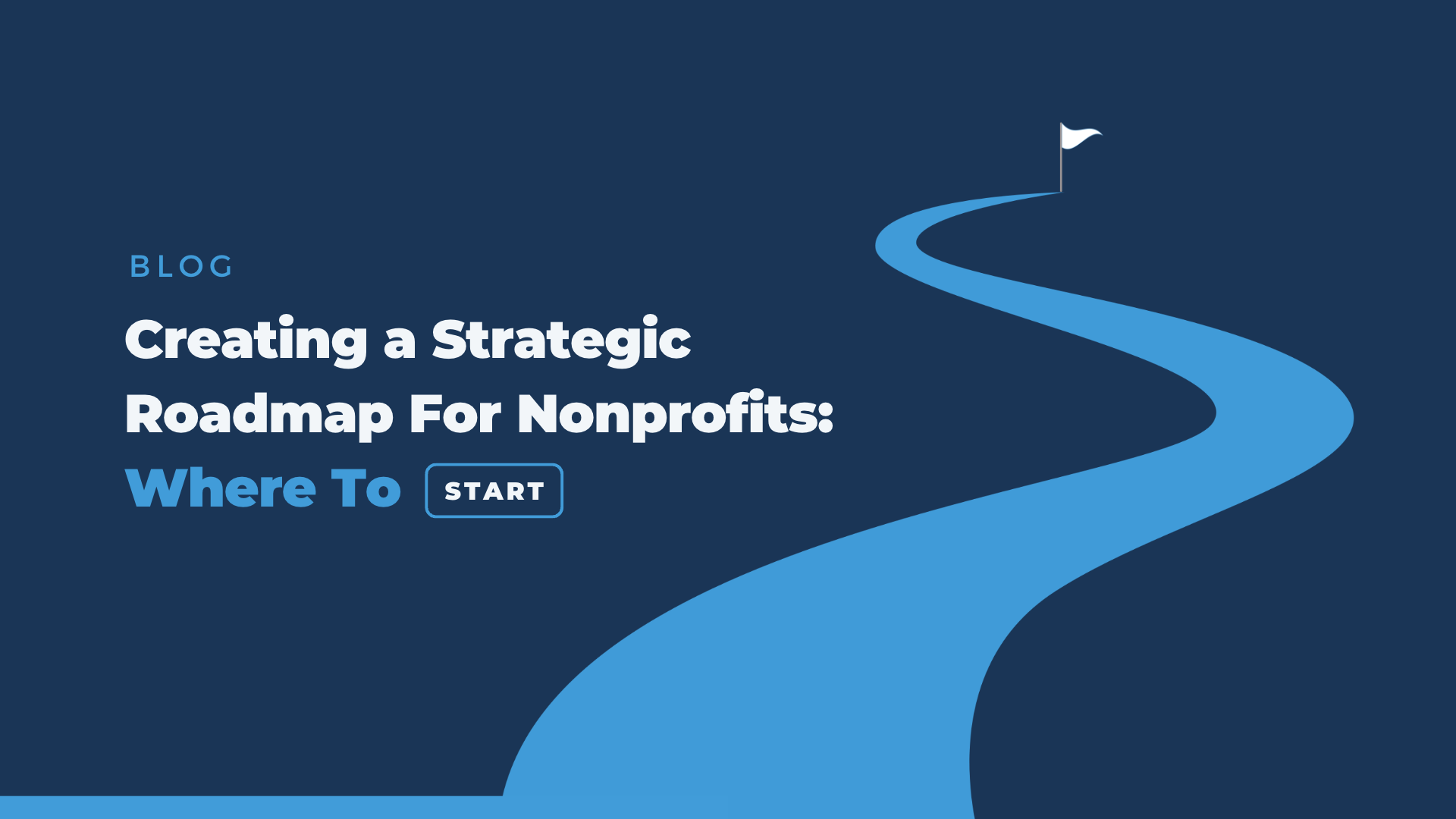Creating a Strategic Roadmap For Nonprofits: Where To Start
Picture this: a group of enthusiastic volunteers gathered around a whiteboard, brainstorming ideas for their nonprofit organization’s future. They throw out buzzwords like “impactful” and “sustainability,” nodding eagerly as they scribble down every idea that pops into their heads.
Fast forward a few weeks later, and the same group of volunteers is now frantically running around, trying to put together a fundraising event with no clear direction. The buzzwords have lost their lustre, and the once-enthusiastic group is now struggling to know what direction to take.
This is where a strategic roadmap comes in. A roadmap is like a treasure map for nonprofits, guiding them toward their goals and providing a clear path forward. Without a roadmap, nonprofits can find themselves lost and directionless.
If you want to avoid the chaos and uncertainty of running a nonprofit without a plan, we’re here to guide you. In this article, we’ll explain how to create a strategic roadmap that will structure your nonprofit’s efforts.
What is a Strategic Roadmap?
A strategic roadmap is a high-level plan that outlines the key objectives and initiatives an organization needs to undertake to achieve its long-term goals. It typically includes a timeline and identifies the resources required to achieve these goals.
In the context of a nonprofit, a strategic roadmap is a planning tool that outlines an organization’s strategic objectives, goals, and action steps over a specific period of time. It provides a clear, comprehensive, and cohesive plan of how the organization will achieve its mission, vision, and goals.
The Benefits of Creating a Strategic Roadmap for Nonprofits
Here are some ways in which nonprofits can benefit from developing a strategic roadmap:
Clear direction
This helps ensure that all stakeholders are aligned and working towards the same objectives.
Nonprofits often have complex goals and many internal and external stakeholders, so a strategic roadmap can help ensure that everyone is aligned and working towards the same objectives. Everyone in your organization can have a shared understanding of what the organization is trying to achieve and how it plans to get there.
Developing a strategic roadmap for your organization is also an effective way to position it to achieve your core mission. Your plan, if crafted correctly, will break your mission up into achievable, measurable, and simple-to-track goals that you can reach one by one as steps toward your ultimate objectives.
Better decision-making
A clearly defined strategic roadmap can help guide tactical decision-making for nonprofits. With a clear understanding of the organization’s goals and objectives, decision-makers can evaluate potential options. They can choose the ones that best align with the organization’s overall strategy, especially when faced with change.
Uncertainty is of course a factor in any business operation. However, your plan can be adjusted and consulted to aid you in proactively planning for uncertainty and tackling challenges when they arise.
Resource allocation
Nonprofits often have finite resources, and a strategic roadmap can help them allocate those resources more effectively. It can help a nonprofit focus on the most important initiatives and align all of its resources around the same objectives.
By identifying the most important goals and objectives, nonprofits can prioritize their resources to achieve the greatest impact.
Improved collaboration
A strategic roadmap can improve team alignment and collaboration among stakeholders. By creating a shared understanding of the organization’s goals and objectives, everyone can work together towards the same vision. This can lead to better teamwork, and ultimately, positive social change.
Increased accountability
A strategic roadmap can help hold nonprofits accountable for achieving their goals. By setting clear objectives and action steps, your team can measure their progress and make adjustments as needed. This can help ensure that the organization is making progress toward its goals and using its resources effectively.
5 Strategic Plan Models for Nonprofits
Every nonprofit organization is unique. This means that there’s no one-size-fits-all approach to creating a strategic roadmap. There are a variety of different models that you can use to craft your own map to reach specific goals and milestones.
These are the most commonly-used plan models for nonprofits:
1. Standard strategic plan model
Also called the basic plan model, this is the most commonly used planning model among nonprofits. We recommend using this model if your organization’s external circumstances – including the economy and funding sources – are generally predictable and calm, and your nonprofit is well established. This model includes a definition of your organization’s goals and mission; specific, shorter term goals; a clear plan to reach these goals, including responsible parties; and a schedule for completing each goal specified.
2. Issue-based strategic plan model
This is better suited to nonprofits operating in unpredictable and agitated conditions, like periods of high staff turnover over a recent change in your leadership. It’s the best plan model to use to get a straying organization back on track. It includes a brainstorm of the factors holding your nonprofit back; a plan to address each of these factors; and a plan for monitoring progress and adjusting your roadmap when necessary.
3. Real-time strategic plan model
This is best for organizations facing crises like recessions or national disasters. It focuses primarily on short-term goals that help you to withstand the storm. It includes regular meet-ups with your team to define short-term objectives; measurements of daily progress and obstacles; and an inventory of progress and damages that is updated as you weather the crisis period.
3. Alignment plan model
This plan is designed to unify individual departments or teams and improve communication. It includes team meetings to clarify challenges; a reiteration of your organization’s common mission; and strategies you can use to improve communication and transparency.
4. Organic strategic plan model
This nonprofit strategic plan model is also ideal for times of uncertainty. It gathers your team to clarify your organization’s mission and goals and determine actionable steps to reach them. The model includes a team meeting or retreat during which you harmonize your understanding of overarching goals; input from your team members on how to reach these goals by certain dates; and regular team meetings to assess progress.
How To Create A Strategic Roadmap Step By Step
Learning how to create a strategic roadmap doesn’t have to be complicated. You can take inspiration from strategic roadmap examples or use a strategic roadmap template. This will contain outlines of all the sections you need to include to simplify the process considerably.
Step 1
Once you have a template or structure in place, it’s time to start developing your mission, values, and vision. That is, why your nonprofit exists and what it aims to achieve.
Include in this strategic roadmapping section a mission statement and a clear, honest vision and values statement.
Step 2
Your plan should include a section for your goals and activities. These goals should be specifically chosen to help you work towards your mission. When you’ve identified them, provide more detail about each goal’s objectives and activities.
Step 3
You will need to assess your environment and resources in your roadmap. These can include factors like internal and external support, financial resources, equipment and facilities, training and skills, and Strength, Weakness, Opportunity and Threat (SWOT) analysis to help you to use your resources as efficiently as possible.
Step 4
Now that you’ve filled in the main sections of your strategic roadmap, you can add additional sections to it. This can include an executive summary, timelines of your goals, financial budgets, and strategies for monitoring progress toward your objectives.
Once you’ve completed your plan, review and edit it as necessary, using your team’s input to clarify points and include realistic deadlines before sharing your plan with your stakeholders.
How Can Exponent Partners Help?
Exponent Partners offers professional roadmapping services for nonprofit organizations. We can help you develop an intentional plan using our strategic discovery process.
Together, we can identify any challenges holding you back and deliver actionable plans that align your team with your long-term goals. Our team comes to the table with proven techniques and workshop strategies to ensure high engagement and an intentional, forward-thinking plan.
How do you create a strategic roadmap? Simple: Contact us so that you can learn more about how you can take your nonprofit to new heights.

